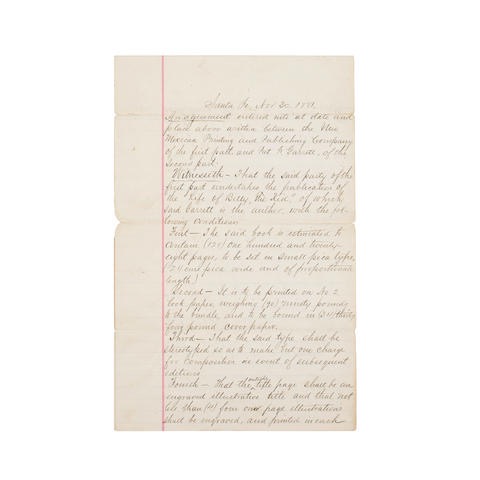PAT GARRETT’S ACTUAL CONTRACT FOR THE PUBLICATION OF THE 1881 BOOK, AUTHENTIC LIFE OF BILLY THE KID.
PATRICK FLOYD. 1850-1908. Document Signed (“Pat F. Garrett”), the agreement between Garrett and the New Mexican Printing and Publishing Company for the publication of his work, 3 pp recto and verso, legal folio (conjoined at upper margin), Santa Fe, NM, November 30, 1881, also signed by manager Chas. W. Greene.
Provenance: purchased from Robert E. McNellis, El Paso, TX, 1978.
ORIGINAL SIGNED CONTRACT FOR THE MOST WELL KNOWN AND RAREST WORKS ON THE WILD WEST, AND THE CORNERSTONE OF THE BILLY THE KID LEGEND.
In part: “That the said party of the first part undertakes the publication of the ‘Life of Billy, the Kid,” of which said Garrett is the author, with the following conditions….” The book is to have 120 pages set in small pica type, to be printed on number 2 book paper, stereotyped, and illustrated. The first edition shall be 5,000 copies, and the publisher shall manage the sale and distribution of the book. For this, Garret is to be paid five cents per copy for the first edition and 8 cents per copy on each copy sold wholesale to news agents and others, with increases in subsequent editions. Garrett also has the right to buy copies to sell himself at a reduced rate. For this, he assigns his copyright to his publisher.”
After Garrett shot William Bonney, known as “Billy the Kid,” in a small New Mexico village, the press of the event portrayed Garrett in a negative light, inspiring him to write, with co-author Ash Upson, his own version of events. Garrett contracted with local Santa Fe publisher Charles W. Greene to produce The Authentic Life of Billy the Kid (the novel’s final title) for the terms listed here. Greene was not up to the task of a national marketing campaign, however, and the book did not sell well, making the first edition one of the rarest titles in the old west canon. For decades Garrett’s book was the primary source for the Billy the Kid legend, but recent scholarship has uncovered factual errors, particularly in the first part, likely written by itinerant journalist and Roswell postmaster Ash Upton. The second half of the book, likely written by Garrett in a more prosaic style, is generally considered to be accurate.




